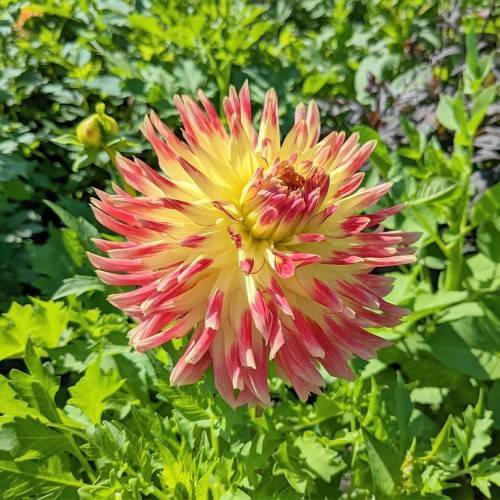
dahlia
Dahlia (group)
Cycle:
Herbaceous Perennial
Watering:
Average
Hardiness Zone:
7 - 10
Flowers:
Flowers
Sun:
Full sun
Growth Rate:
High
Maintenance:
Moderate
Care Level:
High
watering
Dahlias require regular and consistent watering to keep them looking their best. Depending on the climate, you should water your dahlias once or twice a week. In hot summer climates, you will probably need to water more often, as dahlias are very heat sensitive. Generally, water your dahlias early in the morning, as this will give them the longest amount of time to absorb moisture and also help reduce the chances of fungal diseases. When watering, aim for the base of the dahlia plant, since the foliage is better off remaining dry. Soak the soil sufficiently, providing enough water so that the top 6 inches of soil is damp. If the soil still feels dry, give the plant a bit more water.
sunlight
Dahlias require at least 5 to 6 hours of direct sunlight per day in order to thrive. These plants should be kept in a spot outdoors that receives full sun for most of the day. When possible, dahlias should not be kept in an area with partial shade or too much afternoon sun, as these can negatively affect growth and flowering. In areas with extreme hot and intense sun, these plants can be placed in a spot with some shade. It is important to keep dahlias out of strong winds, as this can cause the plants to become sunburnt or dry out.
pruning
Dahlia plants should be pruned once a year during the late winter or early spring before the onset of new growth. Pruning should be done to remove any dead, damaged or diseased branches and leaves, as well as to control the overall size and shape of the plant. Start by cutting the stems back to their base using sharp pruning shears. Work from the outside edges of the plant inward. Second, reduce the plant’s overall size and shape by removing any tips, stems and branches that are growing outward instead of upright. The amount pruned will depend on the size of the plant and the desired shape; generally, a reduction of up to 1-third of the height and spread of the plant is recommended. Pruning in this manner will help the plant to produce more flowers on the remaining stems.
Season
Hardiness Map
FAQ
Is Dahlia a perennial or an annual plant?
Dahlia is a perennial plant, meaning that it will bloom and grow for several years. It is capable of surviving warm and cold climates, with the exception of regions with extreme temperatures. It will go dormant in colder temperatures but will become active again when the ground warms up. Dahlia needs full sun and flowers for most of the summer and into the fall. It is an excellent choice for a garden due to its unique and vibrant colored flowers.
Could Dahlias be grown in pots or containers?
Yes, Dahlias can be grown in pots and containers. When planting, it is important to choose a large container with plenty of room for root growth. The container should be filled with quality potting soil that is well-draining, and not overly wet. When planting and caring for the dahlia plants, ensure the soil is kept moist, but not overly saturated. Also, be careful when watering, as too much water can cause the roots to rot. Regular fertilization will help promote healthy growth and blooming.
Do Dahlias have a fragrance?
Dahlias do have a fragrance - a sweet, floral scent. They usually give off more smell when the blooms begin to fade. Different varieties of dahlias can have different levels of fragrance. The darker bloom varieties have a strong smell while the lighter-colored ones have a milder smell. The intensity of the fragrance will vary with the amount of sunlight they receive.
Should Dahlias be grown from seeds or tubers?
Dahlias can be grown from either seeds or tubers. Growing from tubers is the more popular and recommended method, because it generally gives quicker results. Seed-grown plants require extensive effort to get the desired results, with the advantage of producing an ever-changing array of flowers in many sizes, shapes and colors. Alternatively, tubers produce blooms that are mostly more uniform in characteristics, but with flowers forming in a fraction of the time. So it really comes down to whether you would prefer an assortment of varieties and more effort or quicker production with more uniformity.
Could Dahlias be grown hydroponically?
Yes, dahlias can be grown hydroponically. Hydroponic systems allow plants to grow without the use of soil, instead using a nutrient-rich solution that is delivered directly to the root system of the plant. Dahlias do best in highly oxygenated environments, which a hydroponic setup can provide. Additionally, hydroponic systems can save water by reusing most of the nutrient solution used, plus the lack of soil eliminates the need for weeding, making hydroponic dahlias easy and convenient to care for.
Are Dahlias affected by climate change?
Yes, dahlias can be affected by climate change. Warmer temperatures and more extreme weather patterns can lead to shorter flowering periods, an increase in pests, and an increase in diseases. Additionally, dahlias are heavily reliant on water, so drought can cause them to dry out and not produce flowers. As a result, dahlia growers must be prepared to adapt their growing practices to changes in the climate.
